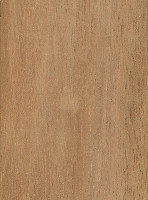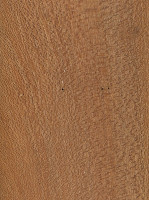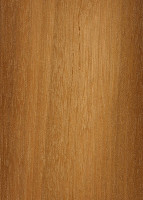The wood name Philippine Mahogany is a loose term that applies to a number of wood species coming from southeast Asia. Another common name for this wood is Meranti: while yet another name that is commonly used when referring to plywood made of this type of wood is Lauan. (And even though it’s called Philippine Mahogany, it bears no relation to what is considered to be “true” mahogany in the Swietenia and Khaya genera—see the article Mahogany Mixups: the Lowdown for more information.)
Scientifically, the name Philippine Mahogany has been used to encompass most commercial lumber found in the Shorea genus, where it is very commonly used in it’s native southeast Asia. There is an abundance of variety between the difference species: each with different working properties, appearances, and mechanical strength values.
The five main groupings for Philippine Mahogany (Meranti/Lauan) are: Light Red Meranti, Dark Red Meranti, White Meranti, Yellow Meranti, and Balau.
 |
 |
 |
 |
 |

I bought this wooden chair at flea market stripped all the layers of paint and found this beautiful wood. Its made in asia. It has no screws holding it together wood dowels is it.please what kind ofwood is this.its a folding lawn chair. Ive never seen one like it
The most important thing is how the wood is treated, meaning the time they took to take the humidity and moisture away.
I just acquired 2 pallets of Filipino Mahogany 1/8 inch thick which I was told was no longer allowed in the US. I didn’t think anything of it because it had been in a storage cellar for so long then someone to me it was from the 1930’s and there was another entire story on what it was used for with instruments and was glad I didn’t make a hasty decision to be rid of it. I would like to know more about it if anyone would be able to assist.
To my knowledge, there is no wood that is simply illegal to own. All current restrictions in the United States center around either harvesting or importing/exporting the wood. You may be confusing things with Honduran mahogany, which is under CITES restriction for import/export without proper certification.
You are correct. It was the importing of it I have is no longer permitted. Thank you.
I just tore out a lot of built in furniture in my 1963 house. One of my helpers suggested that some of the wood was mahogany. I was skeptical owing to mahogany’s exotic reputation, and I had only seen it used in fine antique furniture and darkly stained. So I called my neighbor who is a superb cabinetmaker and wood artisan and who really knows his stuff. He identified it as Lauan, and after reading the above, I am inclined to believe that he is correct. Sigh. Now I need to sift through it all to see if anything is… Read more »
Mahogany wasn’t really expensive in the 1960s, just like redwood was commonly used probably around then and not long after in the 1970s for weather-facing building (the old growth stuff lasts really well exposed to the elements). Even if you had original mahogany, it’s not really that valuable unless it’s in large clear unused boards or enormous components like building beams. in something like cabinets, it’s hard to take components apart and find anything big enough to be used where the labor in cleaning it up would be covered by its value. Second growth mahogany is still available without being… Read more »
Can anyone help ID this sample? I have no experience with tropical hardwoods. Based on my limited knowledge I believe it to be light red meranti (Shorea genus). The wood is very light, soft, easily worked and looks like a mahogany from a distance. (not a true mahogany though). The surface has a feel about the same texture and consistency of 260 grit sand paper. When cut it has a ragged edge. No distinct odour. The wood came from an abandoned Japanese whaling station in Newfoundland. Thinking the wood use may have something to do with ships\boats. Help!
It looks like coco.The wood here in the Philippines.
Curious about this Pan Am memento, which I suspect was carved in the Philippines and purchased by a passenger or crew member on a Pan Am Clipper trip to the Orient in the late 30s. Rough sawn carving wood is heavier than the wood of the brushes.
I can’t tell from those pics, sorry.
The first few remind me very much of coconut wood.
I have a 1950s bedroom set that belong to my grandmother and I am wondering what kind of wood it is.
It does resemble a type of mahogany. I would need a closer view of the endgrain to have any more ideas. Here’s an article on mahogany types: https://www.wood-database.com/wood-articles/mahogany-mixups-the-lowdown/
What wood is this. It came from Philippines. Is this mahogany?
Those appear to be two completely different woods, and I believe neither of them are mahogany. The first could possibly be some type of Albizia, but it’s hard to tell from a single picture. For the second, it appears to be carved of a natural shape in the trunk, so I can’t get a good look at the grain.
Here is another photo
More photos. So this are not mahogany?
It is important to note that the term Philippine mahogany doesn’t really denote true mahogany at all. It is more of a marketing term. See this article: https://www.wood-database.com/wood-articles/mahogany-mixups-the-lowdown/
What wood are this then
I still can’t tell. I would need to see a clear closeup sanded photo of the endgrain to give more details on ID.
Philippine Mahogany often refers to Tanguile, it’s of the Shorea genus. And Mahogany is different. So when the term “Philippine Mahogany” comes up, they mean Tanguile oftentimes (not always, but mostly). And when they only use the term, “Mahogany,” they refer to the actual Mahogany.
But your furniture could be Molave, Narra, or Acacia (as another commenter posted). Look into those. All hardwood.
The wheel bench is Acacia wood
and root bench is mahogany wood…
visit house of furniture philippines
I hope this thread is active, haha.. That sure looks like whatever Luan/Phillipine Mahogany was used in the 1970’s.
I was told this would came from the Philippines… It is quite unique and I would like to know for sure what kind of wood it is.
If it came from the Philippines, you probably have been dooped. Or perhaps you already know about the wood there. I have been living in the Philippines for 13 years and can tell you first hand that they will try to scam you out of your last penny.
is this wood strong for training like wooden swords?
No, it is too low density and open-grained. Mahogany is the local name; it I not mahogany species.
Imported to Australia from Malaysia/Indonesia after WWII, it was called Borneo Cedar but it is not cedar species. When the termites loved it, the importers changed the name to Pacific Maple, but is not maple species either.
Does anyone knows the shearing strength of this tree?
Is this type of wood resistant to termites/pests fungi?
What is the best wood for a house door, need assistance.
Thank you.
Does anyone know what kinda wood this is?
Looks either like African Stinkwood or Tamboeti to me. Both have the very hard dark heart surrounded by yellow sap-wood.
Would this kind of wood be good for protecting a valuable antique snooker cue? If not what kind of wood be best??
Cheers
Sefton.
I’m assuming you are asking about a carrying case. The case construction would be more important than the wood. That said, this wood is soft, like pine, so it would be susceptible to dents and dings. I’d recommend a hardwood with metal corner protectors.
Mahogany is much harder than pine and mahogany is absolutely nothing like pine. Pine is about as soft a softwood as it gets, save for something like balsa. Mahogany machines well with very little grain tear-out – it would work great for any kind of protective case/box.
Phillipine mahogany is not real mahogany. It’s Shorea, a southeast Asian Dipterocarp genus. Mahogany comes from several species of Swietenia, native to the Americas. As far as hardness, it’s probably comparable to mahogany, but talk about machining poorly. Shorea is the worst. There are so many species of Shorea, Swietenia and Pinus as to make any generalizations about hardness impossible. The pine you’re familiar with–the stuff you buy at the big box stores–is pretty soft, but red pine is as hard as hornbeam.
Additionally, periphery mahoganies like sipo and sapele can be quite hard compared to relatively soft genuine mahogany. On the other end of the scale you have spanish cedar (another relative of mahogany) which is softer than many softwoods. You are correct that wild generalizations cannot be made.
We have While Lauan Philippine Mahogany throughout our home (doors, baseboards, trim, etc.) We are currently remodeling the house and will be keeping/refinishing the wood. After cleaning and sanding I’m thinking of using some type of oil product to finish the wood; have you ever refinished this type of wood? If so, what product did you use?
Looking to buy new outdoor tables at https://philippinefurniturestore.com/. Is mahogany a good material?
how high are the mahogany trees?
Its NOT Mahogany!
what IS it!??
Well, the wood name Philippine Mahogany is a loose term that applies to a number of wood species coming from southeast Asia. Another common name for this wood is Meranti: while yet another name that is commonly used when referring to plywood made of this type of wood is Lauan. (And even though it’s called Philippine Mahogany, it bears no relation to what is considered to be “true” mahogany in the Swietenia and Khaya genera—see the article Mahogany Mixups: the Lowdown for more information.) Scientifically, the name Philippine Mahogany has been used to encompass most commercial lumber found in the… Read more »
um… from one perspective yes, but….. you didnt answer what is MAHOGANY (ie, where can we find it), since philippine mahogany isnt lol
Sorry, it appeared you were asking what Phillipine Mahogany was.
As for real Mahogany, this Wiki article does a good job explaining what Mahogany is – https://en.wikipedia.org/wiki/Mahogany
There’s also this article…. https://www.wood-database.com/wood-articles/mahogany-mixups-the-lowdown/
i know what it is, thanks, but if youre going to say Phillipine isnt real mahogany, you gotta back it up ;)
“Back it up”?….really? Do you know where you’re at?
Why don’t read the article these comments are attached to, if you don’t believe me.
I bought Swietenia… is THAT “real” mahogany? or whats the highest quality, rarest, most expensive breed in the world? and can it grow in FL, or only in the Rain Forest?
The answer to your question and any other wood related question you can think of is contained within this website.
yes, within this website, including the threads
Nice bit of blatant plagiarism.
That was part of the point…and he still didn’t get it. Clueless.